
What Material is Stainless Steel?
Table of Contents
Basic Composition
The foundation of stainless steel lies in its unique composition. While primarily made from iron, what makes it truly "stainless" is the addition of at least 10.5% chromium. This crucial threshold of chromium creates a self-healing protective oxide layer on the surface, effectively preventing rust and corrosion. The most common type, known as 304 stainless steel, typically contains:
- 18% chromium
- 8% nickel
- Less than 0.08% carbon
- The remainder is iron
The Role of Key Elements
Each element in stainless steel serves a specific purpose in enhancing its properties:
Chromium is the most crucial element, forming the protective oxide layer that gives stainless steel its corrosion-resistant properties. Exposure to oxygen creates a passive layer with the unique ability to self-repair.
Nickel contributes to the material's formability and weldability while improving its acid resistance. It also enhances the alloy's overall strength.
Though present in small amounts, carbon plays a vital role in strengthening the steel. However, its content is carefully controlled, typically kept below 0.08%, as excessive carbon can compromise corrosion resistance.
When added, molybdenum brings additional benefits, such as improved strength at high temperatures and enhanced resistance to pitting corrosion, particularly in environments with high salt content.
Manufacturing Process
Stainless steel production involves sophisticated metallurgical processes. The three main manufacturing methods include:
- Electric arc furnace smelting, using high current between carbon electrodes
- Blast furnace processing, which consists of melting iron ore with coke
- Vacuum induction melting for producing high-purity metals
Remarkable Properties
What makes stainless steel genuinely exceptional is its combination of properties:
- Outstanding corrosion resistance
- High durability and strength
- Temperature resilience, performing well from cryogenic temperatures up to 2,000°C
- Non-porous and non-reactive nature
- Complete recyclability without quality degradation
- Aesthetic appeal with various finishing options
Environmental Impact
Stainless steel stands out as an environmentally conscious choice. It's 100% recyclable, with a recovery rate approaching 100% in the construction sector. Its durability ensures a long service life, while its inert nature prevents the leaching of compounds when in contact with elements like water.
Applications
The versatility of stainless steel has led to its widespread use across numerous sectors. From everyday kitchen utensils to sophisticated medical instruments, from automotive components to architectural masterpieces, stainless steel proves its worth in various applications. Its strength, durability, and corrosion resistance make it an ideal choice for aesthetic and functional purposes.
In conclusion, stainless steel represents a triumph of metallurgical engineering, combining steel's strength with exceptional corrosion resistance and versatility. Its unique composition and properties have made it an indispensable material in modern industry and daily life, while its recyclability ensures it remains relevant in our increasingly environmentally conscious world.
Conclusion
As a triumph of materials engineering, stainless steel uniquely merges structural strength with environmental responsibility. Its corrosion resistance, adaptability across industries, and infinite recyclability cement its status as an indispensable "green material" for sustainable modern development.
